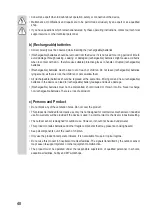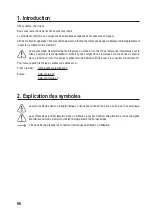
51
• Open the battery compartment cover (J) on the bottom of the outdoor
sensor.
• Insert two AA batteries (not included) into the battery compartment.
Ensure that you observe the plus/+ and minus/- markings.
• The LED indicator (K) will turn on for approximately 4 seconds. It will
then flash every 16 seconds when measurements are sent to the
weather station.
• If the LED indicator (K) does not turn on, check that the batteries are
working and that they are inserted correctly. Inserting the batteries the
wrong way round may cause permanent damage to the temperature
and humidity sensor (E).
• Replace the battery compartment cover.
Use lithium batteries in cold climates (lithium batteries are less sensitive to cold weather). Alkaline batteries
are sufficient for other types of climate.
• The outdoor sensor runs off battery power on overcast days. On sunny days, the solar cell produces electricity,
which is stored by a capacitor for later use. This helps to increase the battery life. One hour of sunshine provides
approximately 7 hours of use. The batteries are used to power the outdoor sensor when the capacitor is empty.
• The batteries in the outdoor sensor should be replaced when the symbol appears on the weather station's LCD
display.
d) Resetting the outdoor sensor
• Reset the outdoor sensor if it stops sending measurements to the weather station.
• Start by covering the solar cell (C).
• Press the
RESET
button (I) for 3 seconds using a sharp object (e.g. a bent paper-clip) to fully discharge the
capacitor.
• Remove the batteries and wait for approximately one minute to ensure that there is no residual voltage in the
system.
• Reinsert the AA batteries and resync the weather station. Ensure that the weather station is no more than 3.3 m
from the outdoor sensor.
•
The solar cell will start to produce electricity when there is sufficient sunlight.
















































